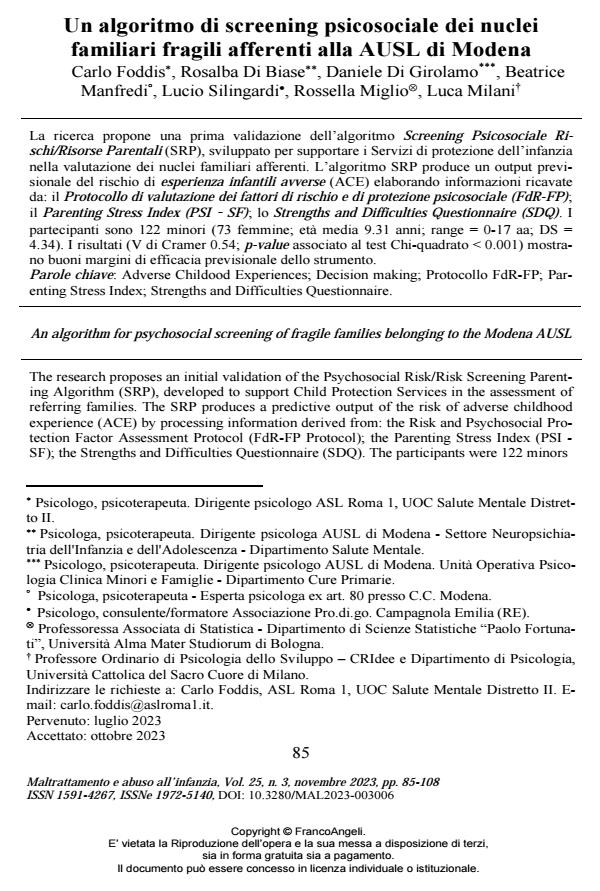An algorithm for psychosocial screening of fragile families belonging to the Modena AUSL
Journal title MALTRATTAMENTO E ABUSO ALL’INFANZIA
Author/s Carlo Foddis, Rosalba Di Biase, Daniele Di Girolamo, Beatrice Manfredi, Lucio Silingardi, Rossella Miglio, Luca Milani
Publishing Year 2024 Issue 2023/3
Language Italian Pages 24 P. 85-108 File size 358 KB
DOI 10.3280/MAL2023-003006
DOI is like a bar code for intellectual property: to have more infomation
click here
Below, you can see the article first page
If you want to buy this article in PDF format, you can do it, following the instructions to buy download credits

FrancoAngeli is member of Publishers International Linking Association, Inc (PILA), a not-for-profit association which run the CrossRef service enabling links to and from online scholarly content.
The research proposes an initial validation of the Psychosocial Risk/Risk Screening Parenting Algorithm (SRP), developed to support Child Protection Services in the assessment of refer-ring families. The SRP produces a predictive output of the risk of adverse childhood experi-ence (ACE) by processing information derived from: the Risk and Psychosocial Protection Factor Assessment Protocol (FdR-FP Protocol); the Parenting Stress Index (PSI - SF); the Strengths and Difficulties Questionnaire (SDQ). The participants were 122 minors (73 females; mean age 9.31 years; range = 0-17 aa; SD = 4.34). The results (Cramer’s V 0.541; p-value associated with Chi-square test < 0.001) show good margins of predictive ef-fectiveness of the instrument.
Keywords: Adverse Childood Experiences; Decision making; FdR-FP Protocol; Parenting Stress Index; Strengths and Difficulties Questionnaire.
- An investigation into the quality of services provided by a psychiatric day center in the representations of the actors involved Carlo Foddis, Giulia Sarnataro, Noemi Carminati, Valeria Di Bartolomei, Natalia Palermo, Eleonora Amicosante, Andrea Colacicco, Chiara Mesoraca, Alessandro Grispini, in RIVISTA DI PSICOLOGIA CLINICA 2/2025 pp.71
DOI: 10.3280/rpc2-2024oa16645
Carlo Foddis, Rosalba Di Biase, Daniele Di Girolamo, Beatrice Manfredi, Lucio Silingardi, Rossella Miglio, Luca Milani, Un algoritmo di screening psicosociale dei nuclei familiari fragili afferenti alla AUSL di Modena in "MALTRATTAMENTO E ABUSO ALL’INFANZIA" 3/2023, pp 85-108, DOI: 10.3280/MAL2023-003006